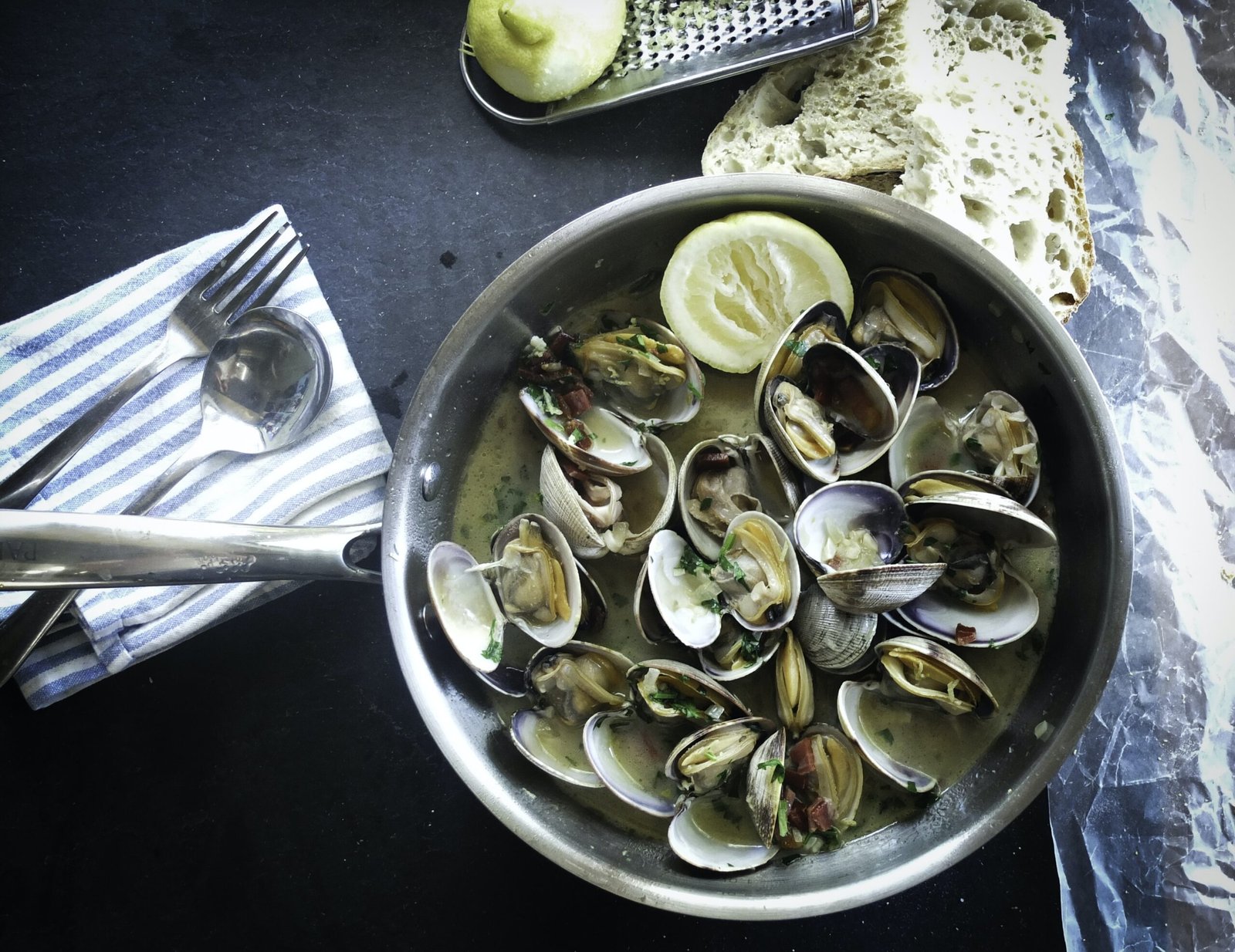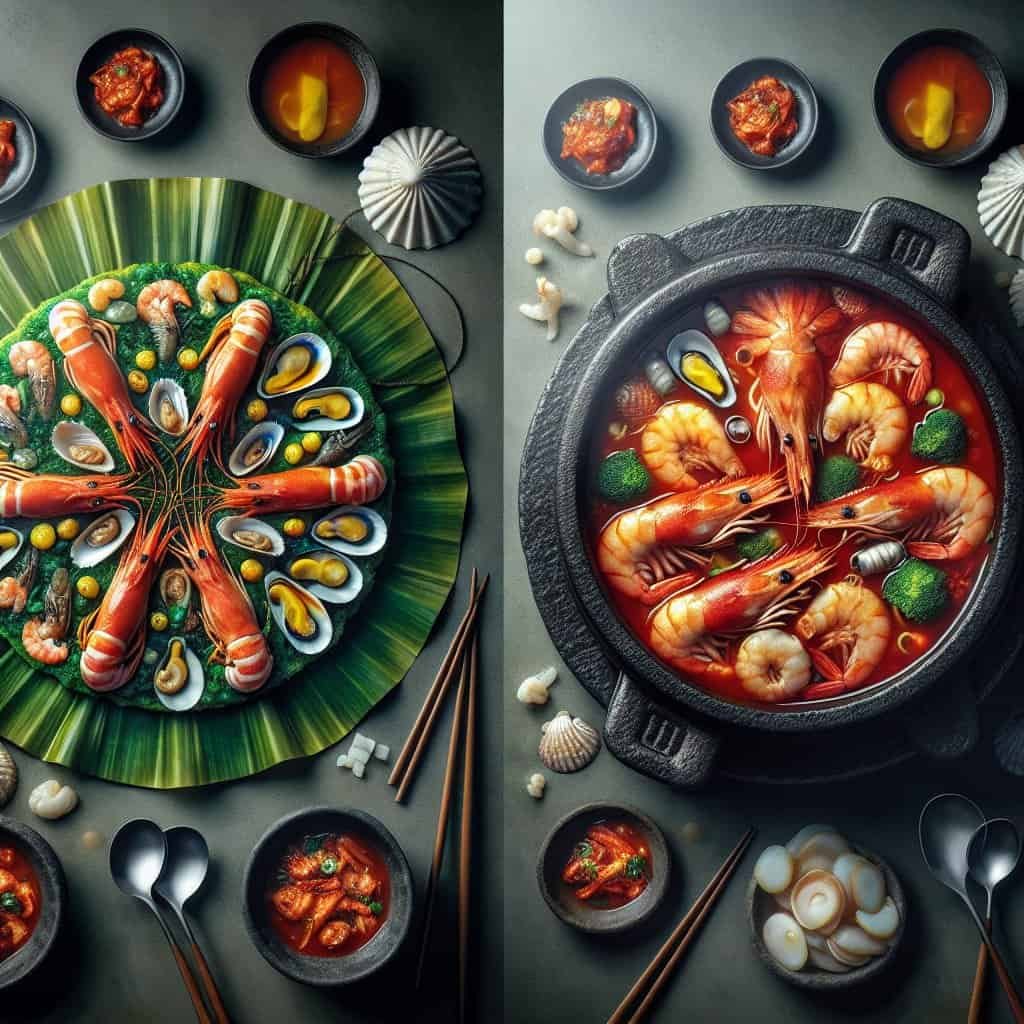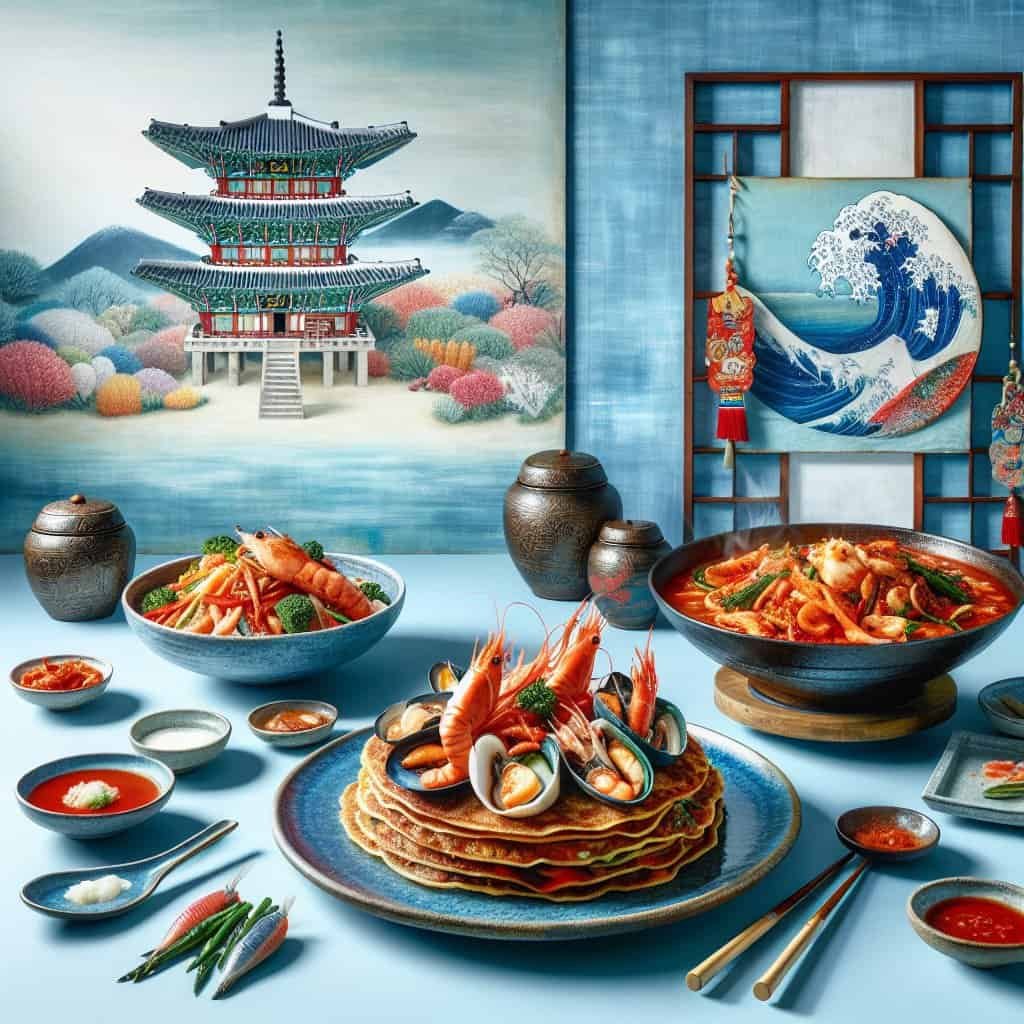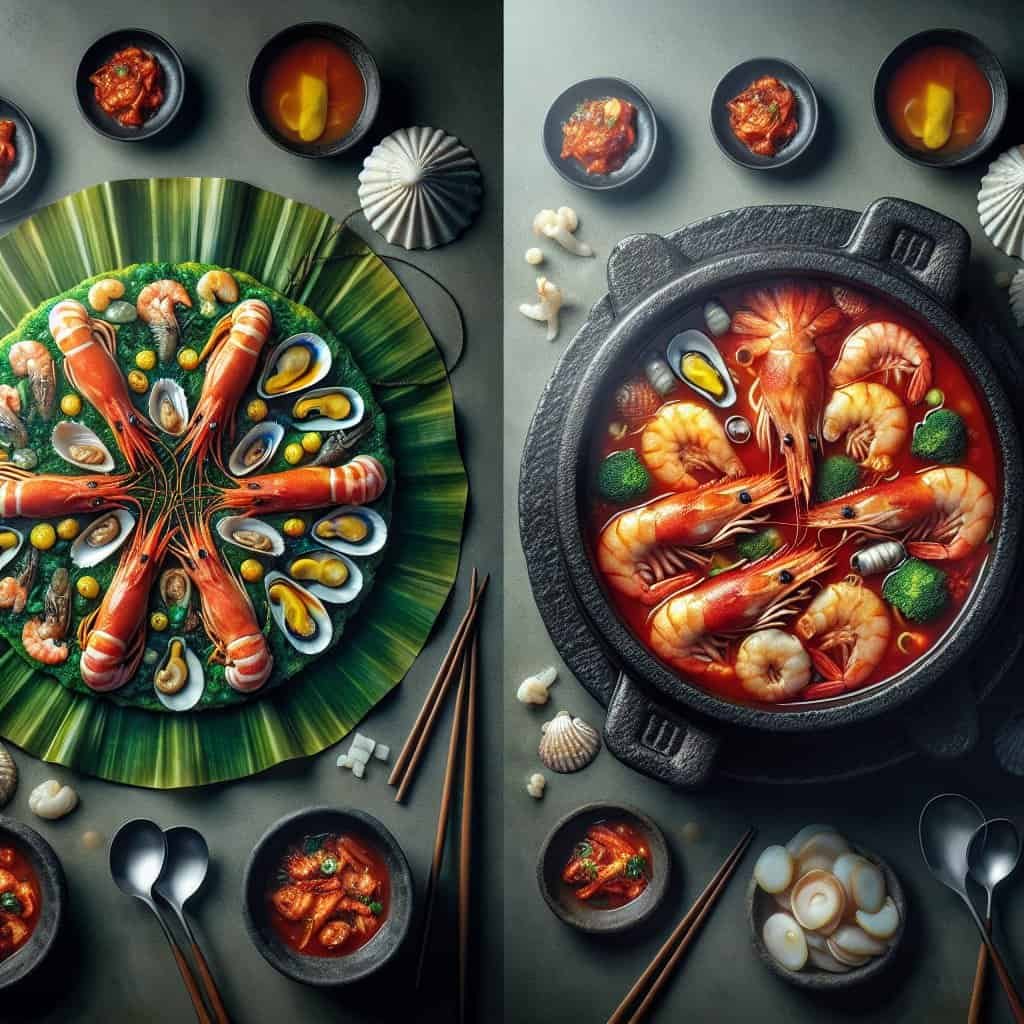Are you a seafood enthusiast looking to explore different culinary traditions? If so, you’ll be thrilled to discover the unique and enticing ways that Korean cuisine incorporates seafood. From mouthwatering seafood pancakes to spicy stir-fried octopus, Korean dishes offer a delightful twist on familiar seafood flavors. Whether you’re an adventurous eater seeking new gustatory experiences or simply curious about the diverse world of Korean cuisine, this article will take you on a flavorful journey through the various ways seafood is skillfully and creatively integrated into Korean dishes. Get ready to satisfy your taste buds and expand your culinary horizons! Korean cuisine is known for its rich and diverse flavors, and seafood plays a prominent role in many traditional dishes. From raw and marinated seafood dishes to grilled and grilled seafood, there are numerous unique ways that Korean cuisine incorporates seafood. Let’s explore some of these delicious and innovative dishes together.

Raw and Marinated Seafood Dishes
Hoe (회)
One of the most popular raw seafood dishes in Korean cuisine is Hoe. It consists of thinly sliced or cubed pieces of fresh raw fish or seafood, marinated in a tangy and savory sauce. The sauce typically includes soy sauce, sesame oil, garlic, and other seasonings. The freshness of the seafood combined with the bold flavors of the marinade creates a delightful culinary experience.
Sannakji (산낙지)
Sannakji is a dish that showcases the unique eating culture in Korea. It consists of live octopus tentacles that are sliced into small pieces and served immediately. The octopus tentacles are incredibly fresh and chewy, providing a one-of-a-kind texture. It’s important to chew thoroughly to enjoy the flavors and avoid any choking hazards. Sannakji is often enjoyed with a spicy dipping sauce.
Jjukkumi (쭈꾸미)
Jjukkumi, also known as baby octopus, is a beloved seafood dish in Korea. These small and tender octopuses are often stir-fried with a spicy gochujang (Korean red chili paste) sauce. The combination of the vibrant flavors from the sauce and the natural sweetness of the octopus creates a delicious and satisfying dish. Jjukkumi is commonly served with vegetables and rice.
Ganzhihwa (간지홍어)
Ganzhihwa, also referred to as marinated skate, is a unique dish commonly enjoyed in Korea. Skate, a type of flatfish, is soaked in a marinade made from soy sauce, garlic, ginger, and other seasonings. The fish is marinated for several hours to allow the flavors to penetrate the meat fully. The result is a tender and flavorful seafood dish with a slightly sweet and salty taste.
Ojingeo Hoe (오징어회)
Ojingeo Hoe, or raw squid, is a popular seafood dish in Korean cuisine. Fresh squid is cleaned and sliced into thin strips before being served raw. The squid is typically marinated in a spicy gochujang sauce or soy sauce-based marinade. The combination of the chewy texture and the bold flavors makes Ojingeo Hoe a delicious and refreshing dish, especially during the hot summer months.
Fermented Seafood Products
Jeotgal (젓갈)
Jeotgal refers to a variety of traditional Korean fermented seafood dishes. Different types of seafood, such as fish, shrimp, and shellfish, are salted and fermented to develop a unique umami flavor. Jeotgal can be enjoyed on its own as a side dish, or it can be used as an ingredient in other dishes to enhance the overall taste.
Myeolchi (멸치)
Myeolchi, or dried anchovies, are an essential ingredient in Korean cuisine. They are often used to make dashi, a flavorful broth that forms the base for many Korean soups and stews. Myeolchi can also be deep-fried and enjoyed as a crunchy snack or used as a topping for various dishes.
Makjeok (막적)
Makjeok is a fermented seafood product made from small squid or cuttlefish. The seafood is salted and fermented for several weeks, resulting in a unique flavor and texture. Makjeok can be enjoyed on its own, or it can be used as a seasoning in various dishes to add a savory and tangy taste.
Jeongol (전골)
Jeongol is a Korean hot pot dish that often incorporates a variety of seafood. It typically contains a combination of seafood, vegetables, and noodles, all cooked together in a flavorful broth. The seafood used in Jeongol can vary, but it often includes ingredients such as shrimp, clams, mussels, and squid. This communal dish is perfect for sharing with friends and family.

Seafood Pancakes
Haemul Pajeon (해물파전)
Haemul Pajeon, or seafood pancake, is a popular Korean dish that features a savory pancake filled with a variety of seafood and green onions. The batter is made from a mixture of flour, eggs, and water, creating a crispy and golden exterior. The seafood used in Haemul Pajeon can include squid, shrimp, and small shellfish. This pancake is often enjoyed with a dipping sauce made from soy sauce and vinegar.
Gamja Pajeon (감자파전)
Gamja Pajeon, or potato pancake, is another delicious variation of the traditional Korean pancake. In this version, grated potatoes are mixed with flour and seasonings before being pan-fried to perfection. While seafood is not a primary ingredient in Gamja Pajeon, it can be added as a topping to enhance the flavors.
Guljeon (굴전)
Guljeon, or oyster pancake, is a specialty dish that showcases the fresh and briny flavors of oysters. The pancake batter is made with flour, eggs, and water, creating a light and crispy texture. Fresh oysters are placed on top of the batter before cooking, resulting in a delightful combination of flavors and textures. Guljeon is often enjoyed with a soy-based dipping sauce.
Grilled and Grilled Seafood
Gulbi Gui (굴비구이)
Gulbi Gui, or grilled dried yellow corvina, is a popular seafood dish often enjoyed in Korea. The fish is first marinated in a mixture of soy sauce, garlic, ginger, and other seasonings before being grilled until tender. The result is a flavorful and succulent grilled fish dish that pairs well with rice and other side dishes.
Saeu Gui (새우구이)
Saeu Gui, or grilled shrimp, is a simple yet delicious way to enjoy seafood in Korea. Fresh shrimp are seasoned with salt and pepper before being grilled to perfection. The natural sweetness of the shrimp is enhanced by the smoky flavors from the grill, creating a delightful culinary experience.
Jjambbong (짬뽕)
Jjambbong is a popular Korean-Chinese dish that combines an array of seafood, vegetables, and noodles in a spicy broth. This hearty and flavorful seafood stew often includes ingredients such as shrimp, squid, mussels, and vegetables like cabbage and carrots. Jjambbong is known for its bold and spicy flavors, making it a favorite among those who enjoy a little heat in their dishes.
Ojingeo Samgyeopsal Gui (오징어삼겹살구이)
Ojingeo Samgyeopsal Gui is a unique fusion dish that combines grilled squid and pork belly. The squid is scored and marinated in a spicy sauce, while the pork belly is seasoned with salt and pepper before being grilled. The combination of the tender squid and the succulent pork belly creates a harmonious blend of flavors. This dish is often served with lettuce wraps and various condiments.

Seafood Soups and Stews
Jogaetang (조개탕)
Jogaetang is a hearty clam soup that is particularly popular during the cold winter months. Fresh clams are cooked in a flavorful broth along with vegetables such as onions, garlic, and Korean radish. The gentle sweetness of the clams infuses the soup, creating a comforting and delicious dish that warms both the body and soul.
Godeungeo Jorim (고등어조림)
Godeungeo Jorim is a braised mackerel dish that is often enjoyed as a side dish or served with rice. The mackerel fillets are simmered in a soy-based sauce until tender and infused with flavor. The result is a rich and savory seafood dish that pairs well with the natural sweetness of rice.
Samgyetang (삼계탕)
Samgyetang is a traditional Korean chicken soup known for its nourishing properties. While chicken is the main ingredient, some variations of Samgyetang include seafood such as abalone or squid. The soup is simmered for several hours with ginseng, garlic, and other medicinal herbs, resulting in a flavorful and comforting dish that is believed to boost one’s health.
Jjampong (짬뽕)
Jjampong is a spicy seafood noodle soup that originated from the Chinese-Chinese dish. This Korean adaptation features a rich and spicy broth filled with an assortment of seafood, including shrimp, squid, mussels, and clams. Jjampong is often enjoyed with noodles and various vegetables, creating a hearty and satisfying meal.
Bibimbap and Rice Dishes
Gyeran Bap (계란밥)
Gyeran Bap, or egg rice, is a simple yet delicious rice dish that incorporates seafood. Cooked rice is mixed with beaten eggs, soy sauce, sesame oil, and other seasonings before being garnished with pieces of cooked fish or seafood. The resulting dish is a comforting and flavorful combination of textures and flavors.
Mul Naengmyeon (물냉면)
Mul Naengmyeon is a refreshing and cold noodle dish that is especially popular during the summer months. The noodles, made from buckwheat or sweet potato starch, are served in an icy cold broth along with various toppings, including thinly sliced seafood such as raw fish or shrimp. The combination of the chilled noodles and the flavors of the seafood creates a delightful and cooling dish.
Hwedupbap (회덮밥)
Hwedupbap is a rice dish that showcases a variety of raw fish or seafood. The fresh seafood is thinly sliced or chopped and served over a bed of rice. The dish is often accompanied by an assortment of vegetables and topped with a spicy gochujang sauce. Hwedupbap is a popular choice for those who enjoy the vibrant flavors and textures of raw seafood.

Seafood Noodles
Jjolmyeon (쫄면)
Jjolmyeon is a type of chewy wheat noodle that is often enjoyed with a spicy sauce. While seafood is not a primary ingredient in Jjolmyeon, it can be added to enhance the flavors. The noodles are typically served cold and mixed with a spicy sauce made from gochujang, vinegar, sugar, and other seasonings. It’s a popular dish during the hot summer months.
Janchi Guksu (잔치국수)
Janchi Guksu, or Korean banquet noodles, is a dish traditionally served during special occasions or celebrations. The noodles are made from wheat flour and served in a light and savory broth along with various toppings. Seafood is often added to enhance the flavors, such as thinly sliced squid or shrimp. Janchi Guksu is a comforting and satisfying noodle dish that brings people together.
Geonbae Jjamppong (건배짬뽕)
Geonbae Jjamppong is a unique twist on the classic Korean-Chinese dish, Jjamppong. In this variation, the dish is made with instant ramen noodles instead of the traditional wheat noodles. Seafood, such as shrimp, squid, and clams, is added to the noodles along with vegetables and a spicy broth. Geonbae Jjamppong is a quick and easy way to enjoy the flavors of Jjamppong with a fun and playful twist.
Rice Cake and Dumpling Dishes
Bungeoppang (붕어빵)
Bungeoppang, also known as fish-shaped bread, is a popular street food in Korea. The snack is made by filling a fish-shaped mold with sweet rice batter and a sweet filling such as red bean paste or cream. While seafood isn’t a primary ingredient in Bungeoppang, the shape of the bread pays homage to the abundance of seafood found in Korean cuisine.
Tteokbokki (떡볶이)
Tteokbokki is a beloved Korean street food dish that features cylindrical rice cakes cooked in a spicy gochujang sauce. While seafood is not a required ingredient in Tteokbokki, many variations include seafood such as fish cakes or shrimps to add extra flavors and textures. The chewy rice cakes combined with the bold and spicy sauce make Tteokbokki a must-try dish for seafood and spice lovers.
Mandu (만두)
Mandu, or dumplings, are a versatile dish that can be enjoyed fried, steamed, or boiled. While variations of mandu can include various fillings, seafood options such as shrimp or squid add a delicious twist to the classic dumpling. Mandu is often served with a dipping sauce and is a popular choice for appetizers or side dishes in Korean cuisine.
Samhap (삼합)
Samhap is a traditional Korean dish that consists of a combination of three main ingredients: dumplings, rice cakes, and noodles. While seafood is not a mandatory ingredient in Samhap, seafood-filled dumplings or thinly sliced seafood can be added to enhance the flavors. The medley of textures and flavors in Samhap creates a satisfying and complete meal.

Traditional Fermented Seafood Dishes
Honghap Jjim (홍합찜)
Honghap Jjim is a traditional Korean dish that showcases steamed mussels in a savory soy-based sauce. The mussels are carefully cooked with various seasonings, including garlic, ginger, and soy sauce, until they become tender and infused with flavor. This dish is often enjoyed as a side dish or served with steamed rice.
Jogae Gui (조개구이)
Jogae Gui, or grilled clams, is a flavorful and simple seafood dish often enjoyed in Korea. Fresh clams are seasoned with salt and pepper before being grilled until they open up. The natural juices from the clams combined with the smoky flavors from the grill create a delightful dish that brings out the sweetness of the clams.
Jokbal (족발)
Jokbal is a popular Korean dish that features braised pig’s feet. While seafood is not a primary ingredient in Jokbal, certain variations of the dish include mussels or shrimp in the braising broth to enhance the flavors further. The tender and savory flavors of the braised meat combined with the richness of the seafood create a unique and delectable dish.
Yeolmu Kimchi (열무김치)
Yeolmu Kimchi is a type of kimchi made from fresh young radishes. While primarily a vegetable dish, Yeolmu Kimchi often incorporates various seafood such as salted shrimp or salted anchovies in the kimchi paste. The addition of seafood enhances the flavors of the kimchi and adds an umami depth to the overall dish.
Seafood Side Dishes
Oi Muchim (오이무침)
Oi Muchim, or seasoned cucumber, is a refreshing side dish commonly found in Korean cuisine. Thinly sliced cucumbers are lightly seasoned with vinegar, soy sauce, sesame oil, and other seasonings. Some variations of Oi Muchim include dried shrimp or fish flakes to add a touch of seafood flavor. This side dish is a perfect accompaniment to spicy main dishes and rice.
Gwi Jorim (귀조림)
Gwi Jorim is a braised dried fish dish that showcases the delicious flavors of the seafood. The dried fish is simmered in a sweet and savory soy-based sauce until it becomes tender and absorbs the flavors of the broth. Gwi Jorim is often served as a side dish alongside rice or as an accompaniment to alcoholic beverages.
Geotjeori (겉절이)
Geotjeori is a type of fresh kimchi served in its early stages of fermentation. While primarily a vegetable dish, Geotjeori can incorporate salted shrimp or anchovies to add a seafood element. The crunchiness of the fresh vegetables combined with the bold flavors of the kimchi creates a delectable side dish that can be enjoyed with various Korean meals.
Sikhye (식혜)
Sikhye, also known as sweet rice punch, is a traditional Korean beverage made from fermented malt and rice. While seafood is not a direct ingredient in Sikhye, certain variations of the beverage can include dried shrimp or other seafood-based ingredients to add complexity to the flavors. Sikhye is often enjoyed as a sweet and refreshing ending to a satisfying Korean meal.
Korean cuisine truly showcases the versatility and creativity when it comes to incorporating seafood into their dishes. From raw and marinated seafood dishes to grilled, soups, and stews, there are endless possibilities to explore and enjoy. Whether you’re a seafood lover or looking to expand your culinary horizons, Korean seafood dishes offer a delightful and unique gastronomic adventure. So, why not dive into the world of Korean seafood cuisine and discover the flavors that await you?
